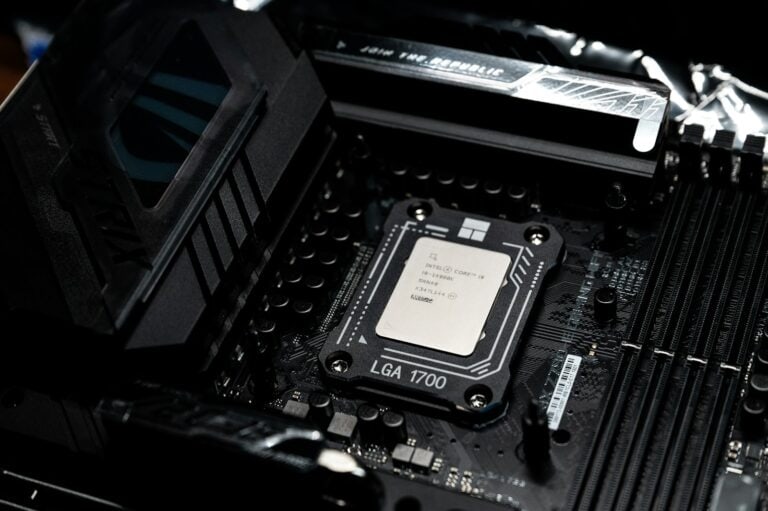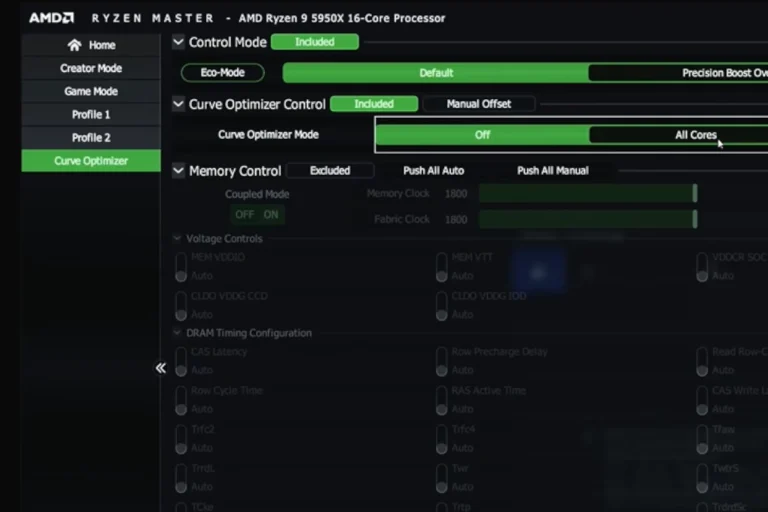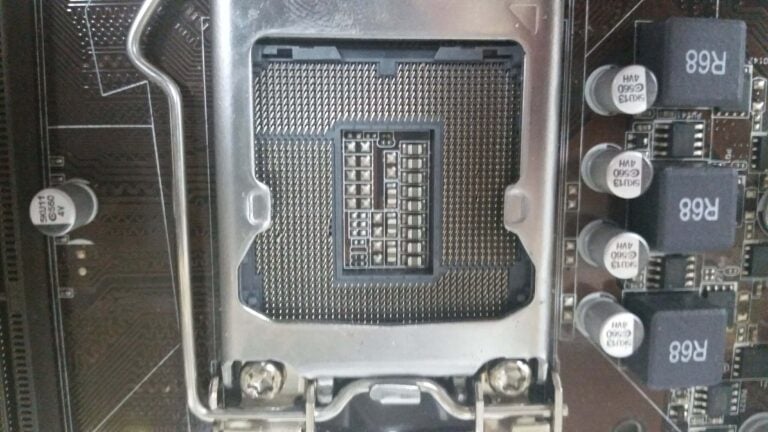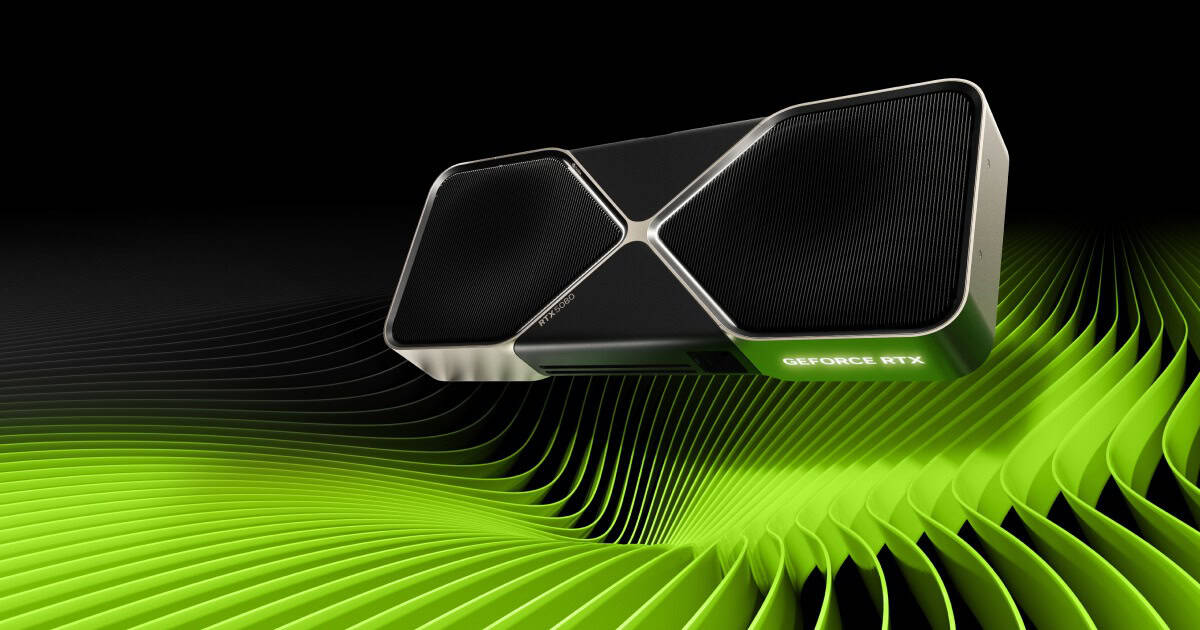
Nvidia has unveiled its latest graphics card lineup, the RTX 50-series, at CES 2025. The new generation, codenamed Blackwell, promises significant performance upgrades for gaming and professional applications. The RTX 5090, Nvidia’s flagship GPU, is priced at $1,999 and boasts twice the performance output of its predecessor.
The RTX 50-series includes a range of models to suit different budgets and needs. The RTX 5080 follows the top-tier 5090, while the RTX 5070 and 5070 Ti are set to release in February 2025 at $549 and $749 respectively. These new GPUs are expected to push the boundaries of graphics processing, offering enhanced ray tracing capabilities and improved AI performance.
Nvidia’s announcement has generated excitement among gamers and professionals alike. The substantial performance gains promised by the RTX 50-series could revolutionize gaming experiences and accelerate workflows in fields such as 3D rendering and AI development. As the market absorbs this news, consumers and industry experts are eager to see how these new GPUs will perform in real-world scenarios.
RTX 50 Series GPU Pricing
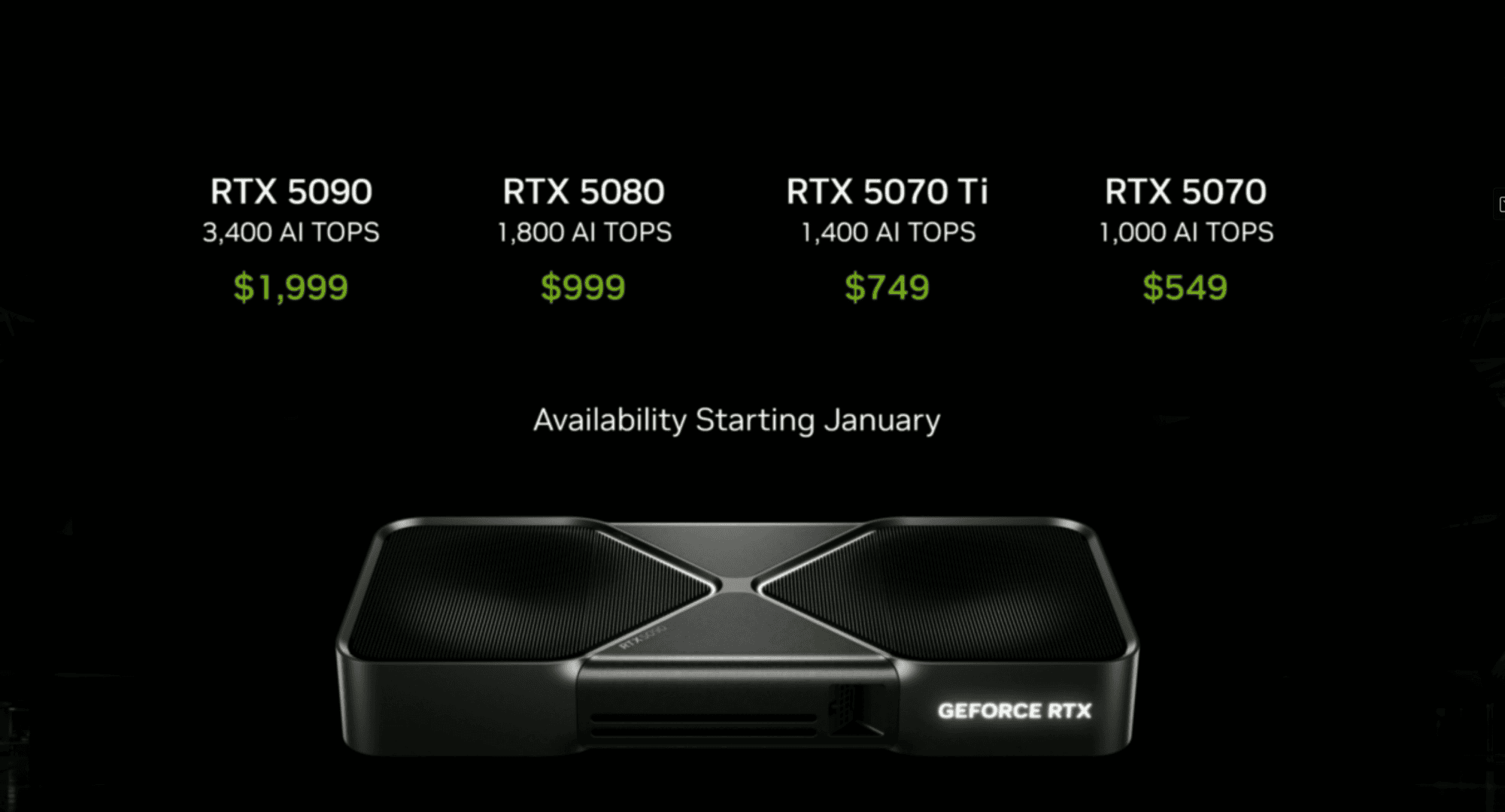
Here’s a table summarizing the Nvidia RTX 50-series graphics cards, including their pricing and key details:
| Model | Price (USD) | Key Features | Release Date |
|---|---|---|---|
| RTX 5070 | $549 | Performance comparable to RTX 4090 (with DLSS 4); Features GDDR7 memory. | February 2025 |
| RTX 5070 Ti | $749 | Enhanced version of RTX 5070 with improved performance; Supports DLSS 4 and GDDR7 memory. | February 2025 |
| RTX 5080 | $999 | Premium performance with significant improvements over the previous generation; GDDR7 memory. | January 30, 2025 |
| RTX 5090 | $1,999 | Flagship model; Twice the speed of RTX 4090; Features GDDR7 memory and DLSS 4. | January 30, 2025 |
These GPUs are expected to revolutionize gaming and rendering with Nvidia’s latest DLSS 4 technology and the use of GDDR7 memory for higher performance and efficiency
Key Takeaways
- Nvidia’s RTX 50-series GPUs offer significant performance improvements over previous generations
- The flagship RTX 5090 is priced at $1,999, with more affordable options available in the lineup
- The new GPUs are set to impact both gaming and professional applications with enhanced capabilities
Overview of RTX 50 Series
Nvidia unveiled its RTX 50 Series graphics cards at CES 2025. The new lineup features the RTX 5090, 5080, 5070 Ti, and 5070 models. These cards are built on the Blackwell architecture, offering significant performance improvements over the previous generation.
The flagship RTX 5090 boasts impressive specifications. It delivers twice the performance of the RTX 4090, making it a powerhouse for gaming and professional applications. Nvidia priced the RTX 5090 at $1,999, matching its predecessor’s launch price.
Key features of the RTX 50 Series include:
- GDDR7 memory
- Enhanced CUDA cores
- Improved ray tracing capabilities
- Advanced tensor cores for AI acceleration
Pricing for the series is as follows:
| Model | Price |
|---|---|
| RTX 5090 | $1,999 |
| RTX 5080 | TBA |
| RTX 5070 Ti | TBA |
| RTX 5070 | $549 |
The RTX 5070 offers an attractive entry point into the new series at $549. This pricing strategy aims to provide improved performance at familiar price points across the range.
Nvidia’s RTX 50 Series represents a significant leap in graphics technology. The new cards promise enhanced gaming experiences and improved productivity for content creators and professionals.
Detailed Pricing Analysis
Nvidia’s RTX 50 series pricing strategy reflects a balance between performance gains and market positioning. The company aims to offer competitive options across different price points while showcasing technological advancements.
Pricing Strategy
Nvidia has adopted a tiered pricing approach for the RTX 50 series. The flagship RTX 5090 is priced at $1,999, maintaining the premium segment. The RTX 5080 comes in at $999, positioning it as a high-end option. For mid-range enthusiasts, the RTX 5070 Ti is set at $749, while the RTX 5070 offers an entry point at $549.
This structure allows Nvidia to target various consumer segments. The high-end models cater to professionals and extreme enthusiasts. Mid-range options appeal to gamers seeking a balance of performance and affordability.
Comparative Price Points
The RTX 50 series pricing shows some shifts compared to previous generations. The RTX 5070 at $549 is priced similarly to its predecessor, the RTX 4070. This suggests Nvidia aims to maintain its market share in the popular mid-range segment.
The RTX 5080’s $999 price tag positions it between the previous RTX 4080 and RTX 4090. This pricing indicates improved performance over the 4080 while offering a more accessible alternative to the top-tier 5090.
| Model | Price |
|---|---|
| RTX 5090 | $1,999 |
| RTX 5080 | $999 |
| RTX 5070 Ti | $749 |
| RTX 5070 | $549 |
Founders Edition and Third-Party Variants
Nvidia’s announced prices likely refer to Founders Edition cards. Third-party manufacturers typically offer variants with custom cooling solutions and factory overclocks. These models often come at a premium over Founders Edition prices.
Entry-level third-party cards may align closely with Nvidia’s MSRP. High-end custom models could see price increases of 10-20% or more. This variation provides consumers with options based on their preferences for cooling, aesthetics, and performance.
Price Influencers
Several factors contribute to the RTX 50 series pricing:
- AI Performance: Enhanced AI capabilities likely justify higher prices for top-tier models.
- Power Efficiency: Improved efficiency may offset some production costs.
- Gaming Performance: Expected gains in frame rates and ray tracing support premium pricing.
- Manufacturing Costs: Advanced production processes influence final retail prices.
- Market Competition: Pricing strategy considers AMD’s competing products.
These elements combine to shape Nvidia’s pricing decisions, balancing technological advancements with market demands and competitive pressures.
Technological Innovations and Performance
The RTX 50 Series GPUs introduce groundbreaking advancements in graphics technology. These innovations span architecture, AI capabilities, and memory systems, delivering significant performance gains for gamers and professionals alike.
Blackwell Architecture
Nvidia’s Blackwell architecture forms the foundation of the RTX 50 Series. It brings substantial improvements in efficiency and performance. The new design allows for higher clock speeds and better power management.
Key features include:
- Enhanced streaming multiprocessors
- Improved cache hierarchy
- Optimized tensor cores
These upgrades result in up to 2x performance gains compared to the previous generation. The RTX 5090 showcases the full potential of Blackwell, offering unparalleled gaming and rendering capabilities.
Deep Learning Super Sampling (DLSS)
DLSS 4 takes AI-powered upscaling to new heights. This technology uses advanced machine learning algorithms to generate high-quality images from lower resolution inputs. Benefits include:
- Increased frame rates
- Sharper image quality
- Reduced GPU load
DLSS 4 supports higher resolutions and offers improved anti-aliasing. It enables smooth 4K and 8K gaming experiences on compatible titles. The RTX 50 Series GPUs leverage dedicated AI hardware to maximize DLSS performance.
AI Tech Advancements
The RTX 50 Series sees a major leap in AI processing power. Nvidia has significantly increased the number of AI TOPS (Trillion Operations Per Second) across the lineup.
AI improvements include:
- Faster inference times
- Enhanced real-time ray tracing denoising
- Improved video encoding and decoding
The RTX 5090 boasts 3,400 AI TOPS, a substantial increase from its predecessor. This boost in AI performance enhances gaming, content creation, and professional applications.
Memory and Bandwidth Capabilities
RTX 50 Series GPUs feature cutting-edge GDDR7 memory. This new memory standard offers higher speeds and improved power efficiency. Key benefits are:
- Increased memory bandwidth
- Lower latency
- Enhanced data transfer rates
The flagship RTX 5090 is expected to feature a large GDDR7 memory pool with impressive bandwidth. This upgrade allows for faster texture loading and smoother performance in memory-intensive tasks.
Market Impact and Consumer Reception
Nvidia’s RTX 50 Series announcement at CES 2025 has sent ripples through the PC gaming industry. The new graphics cards promise significant performance gains and competitive pricing, sparking discussions about their potential impact on the market.
Competitive Landscape
AMD faces renewed pressure from Nvidia’s RTX 50 Series launch. The RTX 5080 and 5070 Ti’s lower price points compared to their predecessors may force AMD to adjust their pricing strategy. Nvidia’s $999 RTX 5080 directly challenges AMD’s high-end offerings, potentially shifting market share dynamics.
Intel’s discrete GPU efforts may struggle to gain traction against Nvidia’s latest innovations. The RTX 50 Series’ AI capabilities and DLSS 4 technology set a new benchmark for graphics performance, raising the bar for competitors.
Anticipated Impact on Gaming Industry
Game developers are expected to leverage the RTX 50 Series’ enhanced ray tracing and AI features. This could lead to more visually stunning and realistic games in the coming years. The improved performance may also push the boundaries of VR gaming.
PC component manufacturers may see increased demand for high-wattage power supplies and cooling solutions. The RTX 5090’s power requirements might drive sales of 1000W+ PSUs.
Consumer Expectations and Reactions
Early reactions to the RTX 50 Series announcement have been largely positive. Gamers appreciate the aggressive pricing of the RTX 5080 and 5070 Ti, seeing them as more attainable upgrades.
Some concerns exist about the RTX 5090’s $1,999 price tag. However, enthusiasts view it as a premium option for those seeking ultimate performance.
Availability worries persist due to ongoing chip shortages. Consumers hope for better stock levels compared to previous launches.
Frequently Asked Questions
The Nvidia RTX 50 series graphics cards have sparked significant interest among consumers. These new GPUs offer improved performance, updated specifications, and varying price points across different models.
What are the specifications for the Nvidia RTX 50 series graphics cards?
The RTX 5090 features 32GB of GDDR7 memory. The RTX 5080 and RTX 5070 Ti both come with 16GB of GDDR7 memory. The RTX 5070 includes 12GB of GDDR7 memory.
Nvidia has not yet released full specifications for clock speeds, CUDA cores, or power consumption. These details are expected to be announced closer to the launch date.
How do the new RTX 50 series cards compare to their predecessors?
Nvidia claims significant performance improvements over the previous generation. Early benchmarks suggest the RTX 5090 may offer up to 50% better performance than the RTX 4090 in some applications.
The RTX 5080 and 5070 Ti are expected to provide similar performance gains over their RTX 40 series counterparts. Exact comparisons will be available once independent reviews are published.
When will the RTX 50 series be available for purchase?
Nvidia announced the following release windows:
- RTX 5090: January 2025
- RTX 5080: February 2025
- RTX 5070 Ti: February 2025
- RTX 5070: February 2025
Specific release dates may vary by region and retailer. Pre-orders are expected to open 1-2 weeks before each card’s launch.
What is the expected price range for the RTX 50 series in different countries?
Nvidia has announced U.S. pricing for the RTX 50 series:
- RTX 5090: $1,999
- RTX 5080: $999
- RTX 5070 Ti: $749
- RTX 5070: $549
Prices in other countries will vary due to taxes, import fees, and currency exchange rates. European prices are typically 10-20% higher than U.S. prices when converted to USD.
Are there any bundled deals available for pre-orders of the RTX 50 series?
Nvidia has not announced any official bundle deals for the RTX 50 series launch. Some retailers may offer game bundles or discounts on accessories with pre-orders.
Customers should check with their preferred retailers for any promotional offers. These deals often vary by region and are subject to change.
Will the RTX 50 series also be available in laptop configurations at launch?
Nvidia has not announced RTX 50 series mobile GPUs for laptops at this time. Typically, laptop versions of new GPU architectures are released a few months after the desktop variants.
Consumers interested in RTX 50 series laptops should expect announcements later in 2025. Exact timing and specifications for mobile GPUs remain unconfirmed.



